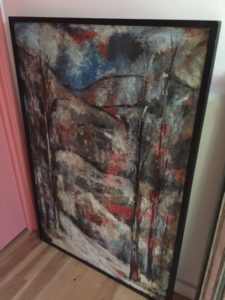 How did a baby born in 1920 in Alton, Iowa, to Eunice and LeRoy, a proud Freemason, grow up to become an abstract painter in Paris? So goes the story of the artist of FR’s painting, Leroy Burket.
How did a baby born in 1920 in Alton, Iowa, to Eunice and LeRoy, a proud Freemason, grow up to become an abstract painter in Paris? So goes the story of the artist of FR’s painting, Leroy Burket.
FR found this sizable (50 x 33”) painting at Alpha Thrift. Not everyone can hang such a piece. FR wondered about it for years. Although it clearly shows a view into a wood-scape, it’s not realistic, and plays abstractly with the colors of blue and red. The signature is hard to make out. What do I do when a client brings me something with an aillegible signature? I squint and imagine different spellings. Then I use Art Net to find a match by looking at the styles of painters whose signature makes sense to me.
Leroy K. Burket a Rather Fine Painter
His works hang at the Museum of Nebraska and the Walker. After he left the University of Iowa, he served in the US Navy (1942-45) aboard the USS Boise. He returned to follow an MFA at the University of Iowa, then got a teaching job at the University of Nebraska. But he longed to travel again, and received a Fulbright to study in Canada and then France. He fell in love with Paris and left his teaching job in 1957 for France. He taught art for the US Army Air Force at Orly Air Base, one of many of the US Airforce bases in Europe, USAFE, located near Paris.
Orly, many of us have traveled through that airport, opened in 1932 as a second airport for France. Formerly the great engineer Eugene Freyssinet used the space as a place for airship hangars.
During WWII, the US established a presence. Later in the war, sadly, so did the Luftwaffe. When the Germans were expelled, the Air Force used Orly as an Advanced Landing Ground “A-47” for the US Army Air Force’s Ninth Air Force. Leroy K. Burket taught art in the buildings erected for at least 500 men stationed there. It became the largest USAF terminal in France in 1955 due to US presence and redevelopment. Although the US returned it to French hands in 1946. The French rebuilt Orly after WWII as a joint civilian airport and NATO facility, supporting Supreme Headquarters Allied Powers Europe (SHAPE) at Rocquencourt. Try to imagine a farm-town boy turned abstract painter teaching art THERE.
Another interesting side to Burket’s artistic life
Leroy K. Burket worked in Paris for Trianon Press, a famous publishing house. In the 1960’s he developed research into and technical support for illustrations for a book of poems by William Blake. I imagine Burket a fascinating man to have such diverse career angles in the art world of his time, the mid-20th century.
Many artists have one career goal, to paint in a certain way. They don’t necessarily teach, they don’t work for publishing houses as illustration advisors. Perhaps commerce detracts from their work. They certainly usually don’t work for the Air Force. But this man became an individual in his time. Just to leave the Midwest in the 1950’s for Paris is a jump enough to tell us that. I like to think this time of lock-down gives us space where many of us think: if we had to do it all over, we might do something bold like Burket? If we have time, focus, creativity, adaptability, flexibility, and a little money, why don’t we make those bold moves when we’re able?
Burket loved to collect art and owned quite a fine collection, some of which ended up in museums, of 18th and 19th century prints, 19th century ceramics, bronze, and all manner of oils on canvas. For a man of such taste, he was acclimated to Paris, and stayed until his death in the late 1980’s, visiting the Midwest every year.
FH’s painting, although not of the style that gets the big bucks by Leroy K. Burket, which are the very abstract organic shapes painted in blurred suggestive colors, is worth much more than a thrift shop price tag. I estimate the value at $2,000 or more, since the painting is decidedly abstract though it’s a semi-recognizable landscape.